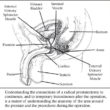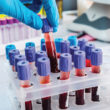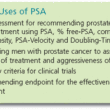Update on the SPORE (Specialized Program of Research Excellence) grant

© Sanford Radom, MD
As the Principal Investigator of the Northwestern University-based Prostate Cancer SPORE (Specialized Program of Research Excellence) Grant from 2015-2021, Dr. Catalona was required by the National Cancer Institute to report on the outcomes of the award. Below is summary of his report to the general public (U.S. taxpayers who funded this research grant).
In patients with low-risk prostate cancer who adopted active surveillance as the initial management, the SPORE Project 1 found clinical and genetic factors that correlated with patients switching sooner from active surveillance to active treatment. The clinical factors were a higher Gleason grade, higher PSA level at diagnosis, higher tumor stage, and a greater number of biopsy cores containing cancer. Two novel findings from exploratory analyses were (1) that patient’s race or genetic ancestry was not correlated with the time to switching to treatment, and (2) patients with low-grade but high-volume tumors behaved more like patients with intermediate- or high-risk disease than those with low-volume, low-grade tumors. Project 1 also detected 18 common genetic variants, called single nucleotide polymorphisms (SNPs), 15 of which previously had not been related to prostate cancer. Additionally, Project 1 found two genes (MAST3 and GAB2) that were significantly related to earlier conversion to treatment. Furthermore, a polygenic risk score based on the number of the 269 established prostate cancer risk SNPs the patient inherited from his parents correlated with earlier switching to treatment, and a different polygenic risk score based on the number of the 36 SNPs affecting PSA levels in individuals also correlated with earlier switching to treatment (the men who were lower PSA producers were more likely to switch sooner). These novel results require replication but suggest that germline genetics testing may help inform and individualize the decision of whether or not a man with low-risk prostate cancer should choose active surveillance or the intensity of monitoring on active surveillance.
Project 2 examined the function of the glucocorticoid receptor (GR) (that regulates the production of cortisol-like hormones) in prostate cancer patients. It revealed that, following primary hormonal therapy aimed at blocking the androgen receptor (AR), among men who had stopped responding to conventional hormonal therapy (i.e. so-called castrate-resistant prostate cancer [CRPC]), drugs that stimulate the GR blocked the growth of prostate cancer cells. However, after Enzalutamide treatment, the main effect of drugs that stimulate the GR was the opposite, i.e., to promote the growth of prostate cancer cells. In experimental animal models, they also teased out key changes in the biochemical pathways, i.e., activation of the GR receptor occurred upstream of the cAMP gene expression pathway, and it leads to increased phosphorylation of a member of this pathway called pCREB. They conducted a clinical trial of a drug that blocks the GR receptor (Relacorilant) and found that giving Enzalutamide and the Relacorilant together reversed a subset of GR target genes and that these drugs are safe and can be combined effectively in prostate cancer patients at doses of 150mg/120mg per day, respectively. At these dose levels, the drug interactions are appropriate and the blocking of GR activity is achieved.
Project 3 found that high expression of a receptor (EPHB4) in cancer cells correlated with poor survival in prostate cancer patients and that blocking this receptor-induced cell death in both hormone-sensitive and castration-resistant prostate cancer cells. Animal experiments showed that treatment with a drug called Ephrin decoy receptor led to tumor shrinkage and cancer cell death.
Further analyses showed an increased infiltration of important immune cells (CD3+ T and NK cells) and increased interferon-gamma production (indicating an immune response) in treated animals, suggesting this agent was able to convert immunologically “cold” tumors (containing few immune cells) to “hot” or inflamed tumors (containing many immune cells) that may respond better to immune checkpoint therapy. A clinical trial of the Ephrin decoy receptor was approved by the FDA and the Institutional Review Board. Fourteen patients were enrolled, but the trial failed to demonstrate the efficacy of the drug. The results suggest that this novel therapy may be better if combined with immunotherapy.
Project 4 provided new insights into an important cancer cell growth-stimulating pathway (the TGFbeta signaling pathway) that underlies the aggressive metastatic forms of prostate cancer. The preclinical results suggest that combining a TGF-beta inhibitor, galunisertib, with established hormonal therapy, such as Enzalutamide, that targets the AR may improve the response to treatment and slow cancer growth. The major achievement of Project 4 was that the investigators were able to take the observation made in the laboratory, namely that the expression of an important gene (FOXA1) in the male hormone signaling pathway was markedly decreased in patients with CRPC and translate this observation into a clinical trial, in collaboration with investigators at Johns Hopkins University. Although the final results of this trial are not yet available, 20 patients have been enrolled at 4 of our SPORE institutions. The results of the correlative studies of biomarkers that may relate to the response or not to treatment must await the completion of the trial.

© Dan Oldfield.





















